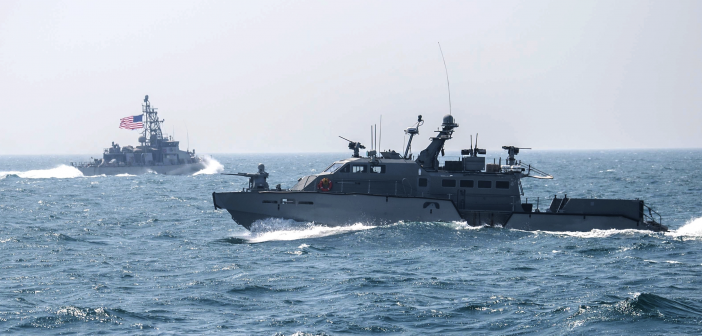When it comes to big things the U. S. Navy has no problem with commitment. The service loves big aircraft carriers, big submarines, big ships – ships that travel on big oceans. It loves to think big – wide-open, transoceanic, blue water operations. Its shopping lists routinely include items costing in the billions of dollars – big bucks.
But when it comes to the small stuff, forget it. While there are passing fancies, the passion soon flames out and Big Navy is on to the next Big Thing.
The latest potential castoffs are some of the smallest ships in the fleet, if at 78-feet long they can be called ships at all. The Mark VI patrol boats began entering service in late 2014 and by 2018 a dozen of a planned fleet of 48 boats had been delivered. The craft were in response to an “urgent need” request from the U. S. Navy in Central Command for fast interceptors to protect big ships in the Persian Gulf from hundreds of small, fast vessels operated by Iran.
The use of small, fast craft to intercept, inspect, ward off and attack potentially hostile craft is key to the safety of the big ships. Since the mid-2000s the U.S. has kept a collection of small patrol vessels based in Bahrain to perform those missions in the Gulf, but these Navy PC “patrol coastals” and U. S. Coast Guard 110-foot patrol boats were not designed for the mission and in any case are all wearing out and in dire need of replacement. Hence the requirement for the Mark VI patrol boats.
Of the first twelve boats delivered to Naval Expeditionary Combat Command (NECC) only three have been sent out to Bahrain while the rest are stateside or in Guam. Yet judging from the Navy’s public relations machine the service is enthusiastic about the craft, routinely featured in pictures and stories featuring their speed, maneuverability and capabilities.
But on February 5 a service-wide message from the director of expeditionary warfare declared all 12 Mark Vis would be inactivated no later than September 30 of this year.
Marine Major General Tracy King, the director of expeditionary warfare, told a Surface Warfare Association audience on Jan. 12 the craft “are very expensive to maintain.” Acknowledging the craft were “very valuable in assuring partners and allies,” he added, “our wargaming has told us we could probably better spend that money elsewhere.”
Rear Admiral Paul Schlise, director of surface warfare and King’s counterpart, noted the PCs are at the end of their service life and now, “there is no plan to replace it with a similar small ship. I think the roles and missions those ships perform are in part going to be replaced by LCSs [littoral combat ships].”
Schlise did not mention that no LCS is yet based in the Persian Gulf, years after the Navy repeatedly declared its intention to do so. Although nearly two dozen LCSs are in service, none have ventured as far as Central Command’s area of operations. It’s also a curious solution since – to say the least — the service has never embraced the littoral combat ship or shown much inclination to make the program work despite a considerable investment that is continuing. Not to mention the LCS was never intended to be a combat escort ship.
While decrying the Mark VIs Schlise and King noted their enthusiasm for a new small ship, the Light Amphibious Warship, or LAW, a new type being developed under the guidance of Marine Corps commandant General David Berger as part of a revised operational concept, Expeditionary Advanced Base Operations. According to the Congressional Research Service, the Navy and Marines want a class of 28 to 30 of the ships, which would be able to carry 75 Marines at sea for a month and beach themselves to put the Marines ashore. The 200- to 400-foot long craft would each cost between $100 million to $150 million – nearly the total cost of the Mark VI program.
The LAW, in other words, is the next shiny object, the latest infatuation, in a line of ship types leading back in time from the Mark VIs to the littoral combat ship to the patrol coastals. The PCs were developed for special forces operators in the 1990s but were out of favor before even five had been completed. Before that were the Asheville-class high-speed gunboats of the 1960s and Pegasus-class hydrofoil missile boats of the 1970s and 1980s. They were busily employed for a brief period but then discarded quickly with no continuation. And the commitment to small minesweepers waxed in the 1980s and then quickly waned, despite the fact that since World War II mines have overwhelmingly damaged more US Navy ships than any other weapon.
All those ship types were part of some urgent need. But as the officials who championed them moved on, all the craft fell out of favor and were thrown away – or the Navy tried to throw them away – well before the normal end of their service lives and long before the investment paid off.
Why? Big Navy routinely looks at smaller ships as bill payers for bigger programs. An even deeper problem is the inability of the surface warfare community to buy into ships smaller than conventional destroyers or frigates. The career path for officers assigned to the small craft has never been clear, with many viewing such assignments as detrimental to meaningful advancement. Fleet concepts of operations, focused on major blue-water conflict, include smaller vessels only with difficulty, despite decades of experience where such craft in confined waters are deeply useful.
Listening to service officials tout the tactical benefits and advantages of the LAW, one has only to realize we’ve heard all this before. With the same urgency, the same enthusiasm, the same message of how useful these small ships will be.
They might even build some LAWs. But if repeated examples of recent history are any guide, the next generation of Navy and Marine officers and planners with their own priorities and viewpoints are very likely to urge the craft be discarded, probably even before the initial group is in service.
Having a clear need and mission is not saving the Mark VIs. The LAW doesn’t even have that. There is no reason to doubt they’ll be just another boondoggle.
11 April 2230
Follow Christopher Cavas on Twitter at @CavasShips




